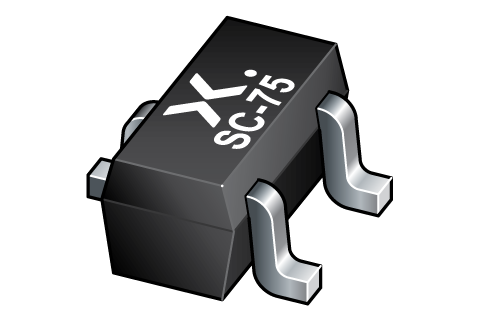
Register once, drag and drop ECAD models into your CAD tool and speed up your design.
Click here for more informationPDTA114EE
PNP resistor-equipped transistors; R1 = 10 kΩ; R2 = 10 kΩ
PNP Resistor-Equipped Transistor (RET) family in small Surface-Mounted Device (SMD) plastic packages.
Features and benefits
- 100 mA output current capability
- Built-in bias resistors
- Simplifies circuit design
- Reduces component count
- Reduces pick and place costs
- AEC-Q101 qualified
Applications
- Digital application in automotive and industrial segments
- Control of IC inputs
- Cost-saving alternative for BC847/857 series in digital applications
- Switching loads
参数类型
| 型号 | Package version | Package name | Size (mm) |
|---|---|---|---|
| PDTA114EE | SOT416 | SC-75 | 1.6 x 0.75 x 0.9 |
封装
下表中的所有产品型号均已停产 。
| 型号 | 可订购的器件编号,(订购码(12NC)) | 状态 | 标示 | 封装 | 外形图 | 回流焊/波峰焊 | 包装 |
|---|---|---|---|---|---|---|---|
| PDTA114EE | PDTA114EE,115 (934051530115) |
Obsolete |

SC-75 (SOT416) |
SOT416 | SOT416_115 | ||
| PDTA114EEAF (934051530135) |
Obsolete | SOT416_135 | |||||
| PDTA114EE/A2,115 (934063174115) |
Obsolete | SOT416_115 |
环境信息
下表中的所有产品型号均已停产 。
| 型号 | 可订购的器件编号 | 化学成分 | RoHS | RHF指示符 |
|---|---|---|---|---|
| PDTA114EE | PDTA114EE,115 | PDTA114EE |
|
|
| PDTA114EE | PDTA114EEAF | PDTA114EE |
|
|
| PDTA114EE | PDTA114EE/A2,115 | PDTA114EE |
|
|
文档 (5)
| 文件名称 | 标题 | 类型 | 日期 |
|---|---|---|---|
| AN90063 | Questions about package outline drawings | Application note | 2025-03-12 |
| Nexperia_package_poster | Nexperia package poster | Leaflet | 2020-05-15 |
| LSYMTRA | Letter Symbols - Transistors; General | Other type | 1999-05-06 |
| SOT416 | plastic, surface-mounted package; 3 leads; 1 mm pitch; 1.6 mm x 0.75 mm x 0.9 mm body | Package information | 2025-01-31 |
| PDTA114EE | PDTA114EE SPICE model | SPICE model | 2024-08-27 |
Longevity
The Nexperia Longevity Program is aimed to provide our customers information from time to time about the expected time that our products can be ordered. The NLP is reviewed and updated regularly by our Executive Management Team. View our longevity program here.
模型
| 文件名称 | 标题 | 类型 | 日期 |
|---|---|---|---|
| PDTA114EE | PDTA114EE SPICE model | SPICE model | 2024-08-27 |
How does it work?
The interactive datasheets are based on the Nexperia MOSFET precision electrothermal models. With our interactive datasheets you can simply specify your own conditions interactively. Start by changing the values of the conditions. You can do this by using the sliders in the condition fields. By dragging the sliders you will see how the MOSFET will perform at the new conditions set.